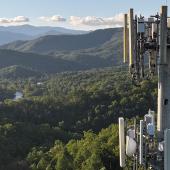Earlier this year, the First Responder Network Authority (FirstNet Authority) announced an investment of $6.3 billion to enhance 5G capabilities on FirstNet. The investment will support the development of a 5G core network, priority and preemption on 5G, expanded mission-critical services, and a 5G deployable fleet, among other enhancements.
This is a major strategic investment in the future of public safety communications. It will ensure public safety’s network keeps pace with technology advancements and first responders’ evolving needs. 5G on FirstNet will generate faster speeds, enhance the quality of service for first responders, and drive innovations in mission critical services.
Why 5G?
FirstNet was first built on 4th generation (4G) technology — also known as long term evolution (LTE). As first responders increasingly integrate broadband into response and operations, they need to be able to access data from widely distributed data sources faster and reliably. 5G meets this need through greater capacity, faster speeds, lower latency, and by supporting massive device connectivity.
Greater capacity
First responders are becoming more mobile and virtual — law enforcement officers are using patrol vehicles as mobile offices, 9-1-1 telecommunicators are taking calls and dispatching remotely, and emergency managers are coordinating response with virtual emergency operation centers.
These critical public safety functions require an immense amount of data. Yet, there are areas of the country that continue to exceed the capacity of 4G networks, fueled by data-intensive applications. The increased capacity of 5G will help ensure that data can be carried across the network to support these data-heavy operational needs.
Ultra-high speeds and ultra-low latency
Body worn camera footage can be a critical situational awareness and safety tool. If that footage is live-streamed, supervisors or dispatch can view it as an incident unfolds to make more informed decisions.
Video is becoming critical to public safety operations in other settings, as well. Firefighters are using drones in high-risk situations where humans can’t go. EMS officials are consulting with remote physicians via telehealth. Demand for these kinds of functions is only expected to increase.
5G on FirstNet will give first responders access to capabilities such as ultra-high speeds and ultra-low latency, reducing lags and delays. When sharing data, like live-streaming video, these features make communications nearly instantaneous.
Massive device connectivity
Responders can get critical information from a wide range of data streams. Internet of Things (IoT) devices such as cameras, sensors, and other connected devices add to a responder’s situational awareness.
When faced with a hazardous materials incident, public safety relies on drone camera footage and sensors to keep responders and the community safe. And with video becoming increasingly prolific, responders have access to many camera sources — body-worn, dash, traffic, drone. These are largely operating and transmitting on wireless networks.
5G supports up to one million devices per square kilometer, allowing first responders to reliably connect to all of the devices they need. This ensures robust communication, even in densely populated urban areas. With applications deployed on the edge network, services are moved closer to the end user. This allows computing resources to be placed closer to the end users, reducing latency and ultimately resulting in an enhanced user experience.
A seamless transition to 5G
In the world of public safety, upgrading communications equipment can be a costly, time-consuming, and arduous process. Upgrades often require new hardware, installation labor, and hours of testing and verifying compatibility with other systems. The evolution to 5G on FirstNet will be a simple process for FirstNet subscribers, bringing a new phase of technology without the responsibilities of a typical equipment upgrade.
Investing in the future
5G on FirstNet will be a major step forward for public safety communications. First responders will gain access to faster speeds, lower latency, and other capabilities that will enhance response operations and open new possibilities for innovation. Learn more about 5G and what it means for FirstNet and public safety in the videos below.




















